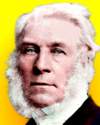
On 7 Apr 1809, James Glaisher was born, a meteorologist who worked at the Royal Observatory, Greenwich. But his activities were far-ranging. When the British Association decided to initiate a new series of balloon ascents, he rode along on 28 of them to make scientific observations.
On 5 Sep 1862, during a balloon trip made to a record height, he lost consciousness. His life was saved by his pilot, despite the disabling effects of the cold the pilot was also suffering.
Glaisher was an interesting scientist, as you will find out by reading this Obituary, (1903).

On 7 April 1911, Kenneth Oakley was born, the English physical anthropologist, geologist, and paleontologist who, in 1953, exposed a dramatic fraud—a forgery known as the “Piltdown Man.” Even today the name sends a shiver down the collective spine of the scientific community, which had been duped by it and misled for decades.
The “Piltdown Man” was an elaborate hoax that kept the scientific establishment guessing for over 50 years. The deception began when skull fragments were “unearthed” of what were unknowingly misidentified to be the “missing link” between humans and apes. The remains were “discovered” in 1912 in a gravel pit at Barkham Manor near the East Sussex village of Piltdown, in south-east England. The hoax wasn’t debunked until 1953
How was this faked “missing link” in human evolution investigated and finally exposed? Today's book pick is: The Piltdown Man Hoax: Case Closed, by Miles Russell, who presents an account like detective story as he puts the scientific findings in a readable and understandable narrative. The author addresses the obvious questions: Who committed the forgery, and why? And how came it that the fraudulent nature of the finds was not discovered when they were first examined by experts? The truth is, indeed, stranger than fiction.
It is available from Amazon, typically about New from $17.73. Used from $3.52. (As of earlier time of writing - subject to change.)
 | The human mind prefers something which it can recognize to something for which it has no name, and, whereas thousands of persons carry field glasses to bring horses, ships, or steeples close to them, only a few carry even the simplest pocket microscope. Yet a small microscope will reveal wonders a thousand times more thrilling than anything which Alice saw behind the looking-glass. |
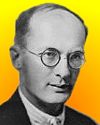 | The time when we could tolerate accounts presenting us the native as a distorted, childish charicature of a human being are gone. This picture is false, and like many other falsehoods, it has been killed by Science. |
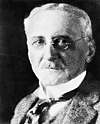 | Man is a megalomaniac among animals—if he sees mountains he will try to imitate them by pyramids, and if he sees some grand process like evolution, and thinks it would be at all possible for him to be in on that game, he would irreverently have to have his whack at that too. That daring megalomania of his—has it not brought him to his present place? |
| Before you look at today's web page, see if you can answer some of these questions about the events that happened on this day. Some of the names are very familiar. Others will likely stump you. Tickle your curiosity with these questions, then check your answers on today's web page. | |
| Births | |
 | Kenneth Oakley, born 7 Apr 1911, was a physical anthropologist, geologist, and paleontologist best known for his work in the relative dating of fossils by analysis of the content of a certain element that that bones would gradually absorb from surrounding soil. He used this method to expose as a forgery the “Piltdown Man” skull fragments “unearthed” in 1912, that had for decades been said to represent the “missing link” in human evolution. He proved the true age of the bones to be a modern human braincase and an orangutan jawbone. The bones of the forgery had been chemically stained to appear ancient. Which chemical element was studied in Oakley’s analysis technique? |
 | Jacques Loeb, born 7 Apr 1859, was a German-born American biologist noted chiefly for his experimental work on artificial parthenogenesis, which he deomstrated with urchins and frogs. What is parthenogenesis? |
| Deaths | |
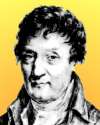 | A French mathematician, physicist, and inventor (1746-1823) is best known for his law concerning the thermal expansion of gases that for a gas at constant pressure: its volume is directly proportional to its absolute temperature. He also was active in popularizing Benjamin Franklin’s theory of electricity. Further, he made several balloon ascents, was the first to use hydrogen for balloon inflation and invented most of the equipment that is still used in today’s balloons. What is the name of this scientist? |
| Events | |
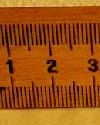 | On 7 Apr 1795, France adopted by law, the metre as the unit of length for a metric system. Since there had been no uniformity of French weights and measures prior to the Revolution, the Academy of Sciences had been charged to devise a better system. The new metre was thus defined in 1795 as the measure of a one ten-millionth part of a certain distance. What distance was chosen for this definition of the metre? |
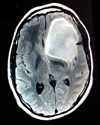 | On 7 Apr of a certain year, surgery for the removal of a brain tumor was performed. It was notable as it was the first time only a local anesthetic was used (cocaine on the scalp). The condition of the patient, Henry A. Brown, had been deemed too risky for the usual general anesthesia. He remained fully conscious while his skull was opened, able to answer the doctors’ questions and was reported to have “cooperated cheerfully”. In which decade did this first brain tumor surgery with only local anesthetic performed? [Hint: it was before any MRI as shown in the thumbnail image was available.] |
Fast answers for the previous newsletter for April 6: the decade including the year 1962 • xenon • brightness of the dimly illuminated dark area of the moon, due to light reflected from Earth • biochemistry • Teflon.
 If you enjoy this newsletter, the website, or wish to offer encouragement or ideas, please send feedback by using your mail reader Reply button.
If you enjoy this newsletter, the website, or wish to offer encouragement or ideas, please send feedback by using your mail reader Reply button. Your click on a Facebook, StumbleUpon, or other social button on the site webpages is also a welcome sign of appreciation. Thank you for using them.
© This newsletter is copyright 2020 by todayinsci.com. Please respect the Webmaster's wishes and do not put copies online of the Newsletter — or any Today in Science History webpage. (If you already have done so, please remove them. Thank you.) Offline use in education is encouraged such as a printout on a bulletin board, or projected for classroom viewing. Online, descriptive links to our pages are welcomed, as these will provide a reader with the most recent revisions, additions and/or corrections of a webpage. For any other copyright questions, please contact the Webmaster by using your mail reader Reply button.
--
If you do not want to receive any more newsletters, Unsubscribe
To update your preferences and to unsubscribe visit this link
Executive Real Estate Business Class
-
"It was like a man with wings. It wasn't like anything you'd see on TV or in a monster movie." ...
About the publisher
Search This Blog
Blog Archive
-
▼
2021
(585)
-
▼
April
(57)
- On This Day for April 30 - George Washington inaug...
- Newsletter for Friday 30 April.
- On This Day for April 29 - British royal wedding, ...
- Newsletter for Thursday 29 April.
- On This Day for April 28 - Benito Mussolini execut...
- Newsletter for Wednesday 28 April.
- On This Day for April 27 - Independence for Sierra...
- Newsletter for Tuesday 27 April.
- On This Day for April 26 - Chernobyl nuclear accid...
- Newsletter for Monday 26 April.
- On This Day for April 25 - Hubble Space Telescope ...
- See How They Tracked Down Bin Laden
- Newsletter for Sunday 25 April.
- On This Day for April 24 - Installation of Pope Be...
- Newsletter for Saturday 24 April.
- On This Day for April 23 - Voting for Eritrea's in...
- Earth Day Bonus: Become a Climate Action Expert
- On This Day for April 22 - First Earth Day, Miguel...
- On This Day for April 21 - French elections held, ...
- Newsletter for Wednesday 21 April.
- On This Day for April 20 - Explosion on the Deepwa...
- Newsletter for Tuesday 20 April.
- On This Day for April 19 - American Revolution beg...
- Newsletter for Monday 19 April.
- On This Day for April 18 - The midnight ride of Pa...
- Newsletter for Sunday 18 April.
- On This Day for April 17 - Canada Act proclaimed, ...
- Newsletter for Saturday 17 April.
- On This Day for April 16 - Harriet Quimby's flight...
- Newsletter for Friday 16 April.
- On This Day for April 15 - Sinking of the Titanic,...
- Newsletter for Thursday 15 April.
- On This Day for April 14 - Abraham Lincoln shot, J...
- On This Day for April 13 - Alfred Dreyfus imprison...
- Newsletter for Tuesday 13 April.
- On This Day for April 12 - Launch of first space s...
- Newsletter for Monday 12 April.
- John of Gaunt: father of England’s medieval monarchy
- On This Day for April 11 - Napoleon's abdication a...
- Newsletter for Sunday 11 April.
- On This Day for April 10 - Anschluss approved in A...
- On This Day for April 9 - Fall of Baghdad, Jørn Ut...
- Newsletter for Friday 9 April.
- On This Day for April 8 - Celebration of the Buddh...
- On This Day for April 7 - Jack Nicklaus's first Ma...
- Newsletter for Wednesday 7 April.
- On This Day for April 6 - Olympics revived, Raphae...
- On This Day for April 5 - Battle of Maipú, Colin P...
- The history and origins of Easter
- On This Day for April 4 - Martin Luther King, Jr.,...
- Newsletter for Sunday 4 April.
- On This Day for April 3 - Implementation of the Ma...
- Newsletter for Saturday 3 April.
- On This Day for April 2 - Death of Pope John Paul ...
- Newsletter for Friday 2 April.
- On This Day for April 1 - Creation of Nunavut, Ser...
- Newsletter for Thursday 1 April.
-
▼
April
(57)
-
Blogroll
-
About
HistoryFact










0 comments:
Post a Comment